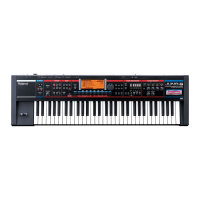System and settings
Internal structure
To have a clear understanding of how the Juno-G works, please have a
look at it’s internal structure diagram:
Synthesizer
Flash RAM
PC card
Eects
ROM
SRX
Sequencer
Arpeggiator
Rhythm machine
Keyboard
Controllers
USB MIDI
IN
RAM
DIMM
A
B
The keyboard and controllers send MIDI messages to the synthesizer
and this information can also be recorded into the sequencer.
The synthesizer has 16 instrument parts and 128-voice polyphony. The
sounds it produces are based on waveforms from the static memory, ROM (64
MB standard, expandable to 128 MB with one SRX series card), and dynamic
sample memory, RAM (4 МB standard, expandable to 516 MB with a DIMM
memory module).
The eects units can process both the internal synthesizer sounds and
sound from the external line/mic input. Juno-G has 3 multi-eect processors,
chorus and reverb processors and a dedicated input processor. There are two
independent stereo outputs (A and B). The sound Juno-G produces can be
recorded into the sampler or the sequencer’s audio tracks.
3

